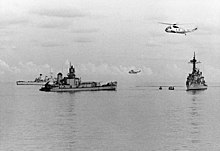USS Georgia (BB-15)
USS Georgia (Battleship # 15) Making 17.707 knots on Run # 9 of her trials, 13 June 1906. Note that her six-inch broadside guns have not yet been installed.
USS Georgia (BB-15) was a United States Navy Virginia-class battleship, the third of five ships of the class. She was built by the Bath Iron Works in Maine, with her keel laid in August 1901 and her launching in October 1904. The completed battleship was commissioned into the fleet in September 1906. The ship was armed with an offensive battery of four 12-inch (305 mm) guns and eight 8-inch (203 mm) guns, and she was capable of a top speed of 19 knots (35 km/h; 22 mph).
Georgia spent the majority of her career in the Atlantic Fleet. In 1907, she took part in the Jamestown Exposition and suffered an explosion in her aft 8-inch gun turret that killed or wounded 21 men. At the end of the year, she joined the Great White Fleet on its circumnavigation of the globe, which ended in early 1909. Peacetime training followed for the next five years, and in 1914 she cruised in Mexican waters to protect American interests during the Mexican Revolution. In early 1916, the ship was temporarily decommissioned.
When the United States entered World War I in April 1917, the ship was tasked with training naval recruits for the expanding wartime fleet. Starting in September 1918, she was used as a convoy escort. Her only casualties during the war were due to disease, the result of poor conditions and severe overcrowding aboard the ship. Georgia was used to transport American soldiers back from France in 1918–1919, and the following year she was transferred to the Pacific Fleet, where she served as the flagship of the 2nd Division, 1st Squadron. The Washington Naval Treaty, signed in 1922, cut short the ship’s career, as it mandated severe draw-downs in naval strength. Georgia was accordingly sold for scrap in November 1923.
https://ift.tt/klnqaDt
from Blogger https://ift.tt/1KHXshW
via IFTTT















